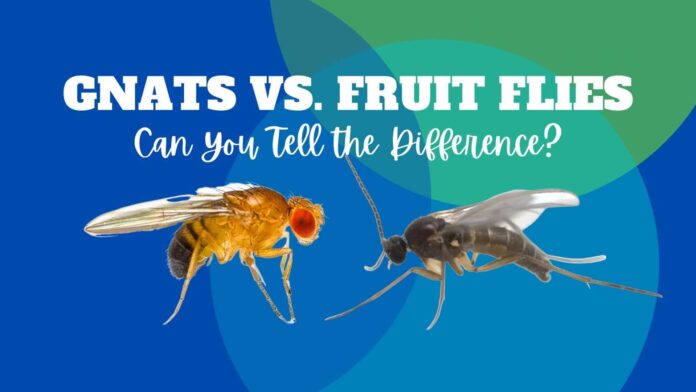Have you spotted tiny insects in your home and aren’t sure whether they’re fruit flies or gnats? They may look similar at first glance, but these pests are quite different. Understanding their differences can help you deal with them more effectively. This guide will explain fruit flies vs gnats, focusing on their appearance, habitats, behavior, and how to get rid of them.
Key Differences of Fruit Flies vs Gnats
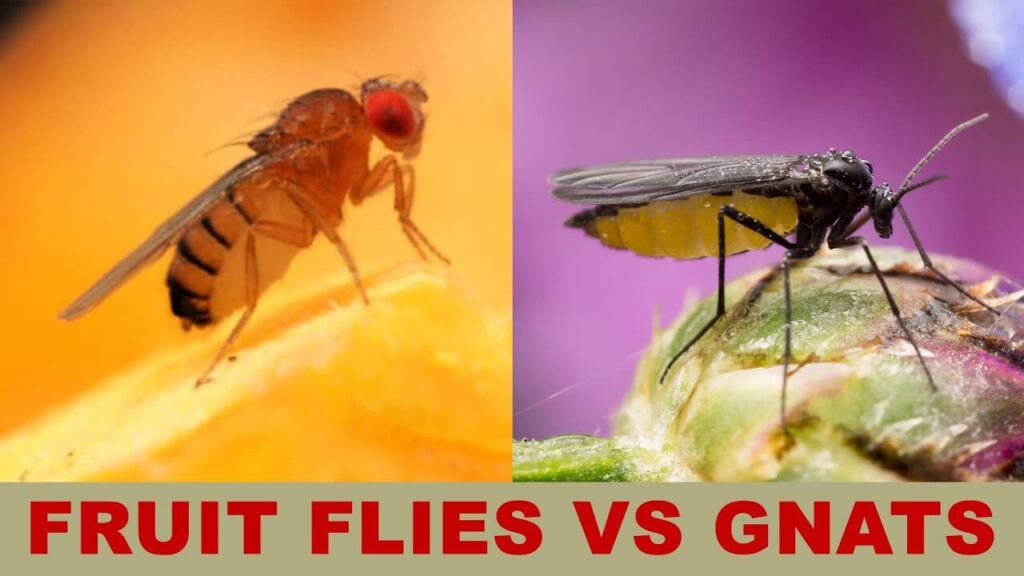
Appearance
When it comes to gnats vs fruit flies, appearance is the first clue to identify them.
Fruit Flies
- Color: Tan to light brown, sometimes a darker brownish-black.
- Body Shape: Small, round, and slightly similar to a tiny housefly.
- Eye Color: Bright red eyes, which are very noticeable.
- Size: About 1/8 inch long, making them slightly larger than gnats.
Gnats
- Color: Dark gray or black.
- Body Shape: Long and narrow, resembling a small mosquito.
- Eyes: Extremely small and not as noticeable as those of fruit flies.
- Size: Smaller than fruit flies, usually less than 1/8 inch long.
If you encounter a rounded insect near your kitchen, it’s likely a fruit fly. However, a long, mosquito-shaped insect hovering around your plants is probably a gnat.
Fruit Flies vs Gnats: Habitat and Behavior
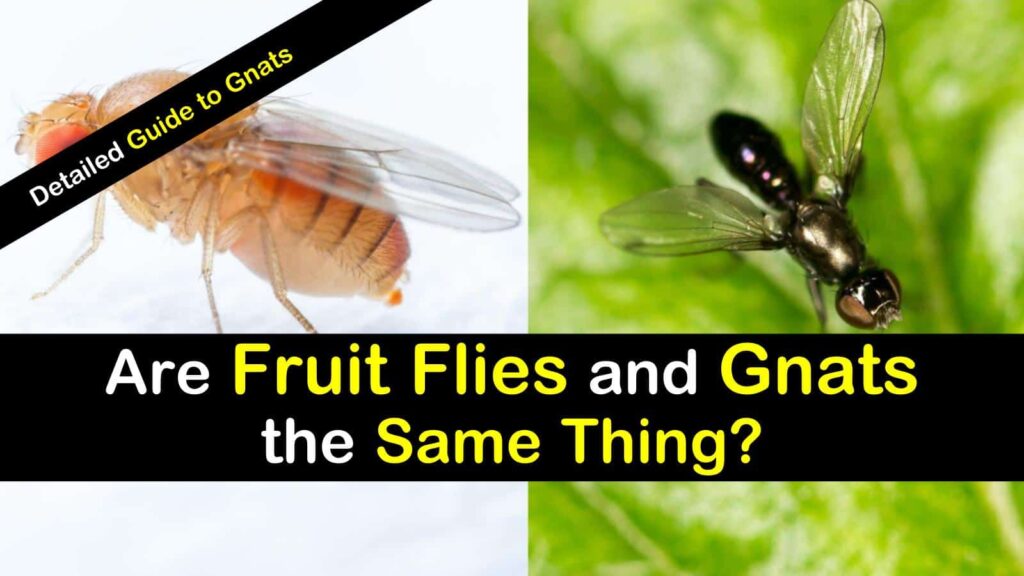
Understanding where these insects live and what they do can also help distinguish between house gnats and fruit flies.
Fruit Flies
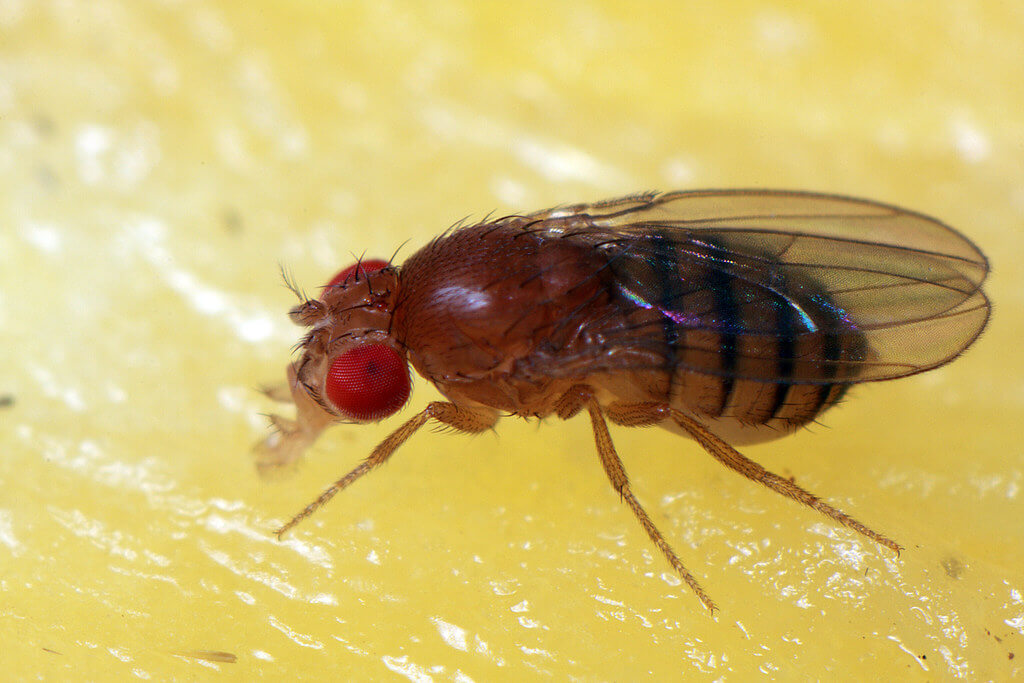
Fruit flies are attracted to anything that is overripe, rotting, or fermenting.
- Habitat: Kitchens, especially near fruit bowls, trash cans, or drains with organic buildup.
- Behavior: They lay their eggs on overripe fruit or in drains where food debris has collected. Once hatched, the larvae feed on organic matter.
Gnats
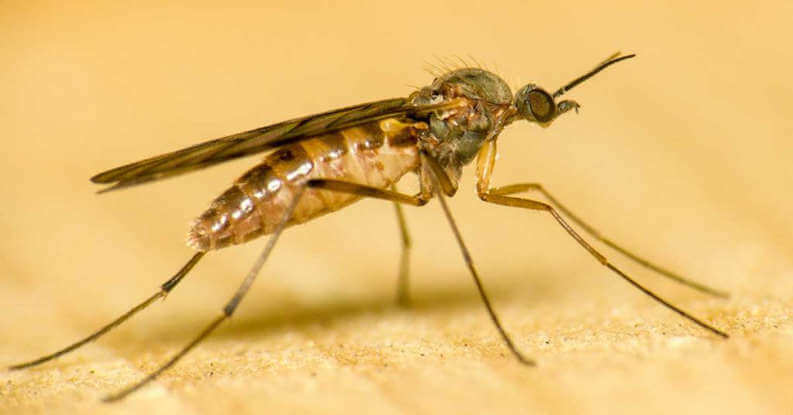
Gnats, particularly fungus gnats, prefer moist and damp areas.
- Habitat: Often found near potted plants, gardens, or areas with excessive moisture.
- Behavior: Gnats lay eggs in moist soil, and the larvae feed on plant roots and organic matter in the soil.
If you’re spotting insects near your houseplants, they’re probably gnats. On the other hand, seeing them around your kitchen suggests the presence of fruit flies.
Read our Latest Posts on Bed Bugs:
- How to Tell if You Have Bed Bugs in Your House?
- How to Get Rid of Bed Bugs Permanently at Home Naturally in 2025
- How Much Does it Cost to Get Rid of Bed Bugs? 2025 Pricing Guide
- What Do Bed Bugs Look Like?
- Early Signs of Bed Bugs on Mattress? Explained in 2025
How to Identify Gnats vs Fruit Flies?
Identifying these pests is crucial to effectively eliminating them. Use these tips to differentiate fruit flies vs gnats quickly.
- Location Clues:
- Fruit flies are often near fruit, garbage, or drains.
- Gnats gather around damp soil or plants.
- Look for Swarms:
- Gnats may hover in groups, particularly around houseplants.
- Fruit flies buzz around food or sticky surfaces like soda spills.
- Check for Habitats:
- For fruit flies, search for overripe fruit or dirty drains.
- For gnats, inspect plant soils.
Knowing where these insects are most often found will help you deal with them effectively.
Treatment and Prevention of Gnats and Fruit Flies
Both fruit flies and gnats reproduce rapidly, so quick action is important. Here are ways to treat and prevent infestations.
Fruit Flies
- Homemade Traps: Use apple cider vinegar with a drop of dish soap. Fruit flies are attracted to the vinegar and get trapped.
- Drain Cleaning: Wash out drains with a mixture of baking soda and vinegar to remove food debris.
- Trash Management: Keep trash cans clean and sealed.
Gnats
- Plant Care: Avoid overwatering plants. Check topsoil for dampness and ensure pots drain well.
- Traps: Use sticky traps near houseplants to catch adult gnats.
- Natural Solutions: Sprinkle cinnamon or apply Bacillus thuringiensis (Bt), a natural soil treatment to kill larvae.
General Prevention Tips if you have Gnats vs Fruit Flies in the House
- Clean Regularly: Keep your kitchen and plants tidy.
- Remove Moisture: Fix leaks and avoid leaving standing water.
- Inspect New Plants: Check for larvae in the soil before bringing plants home.
If these DIY approaches don’t work, consider calling pest control experts like Orkin or Pronto Pest Management for professional help.
Conclusion
While fruit flies and gnats might seem alike, they’re distinct in appearance, habitat, and behavior. Fruit flies are round with red eyes, often near kitchens, while gnats are long and found around moist soil or plants. Knowing how to identify and treat these pests early can keep your home clean and pest-free. Take preventive measures to stop them from multiplying and reach out to professionals if needed. Understanding fruit flies vs gnats is the first step to winning this battle against these pesky invaders. Follow Us on Facebook, Pinterest and Twitter for the latest updates.
FAQs
How do I know if I have gnats or fruit flies?
Look at where they gather. Gnats swarm near plants, while fruit flies gather by food or trash.
What are the signs of a drain gnat infestation?
Drain gnats often fly out of drains or around standing water. Inspect and clean drains regularly.
What can be mistaken for fruit flies in the house?
Drain flies and gnats are commonly mistaken for fruit flies but differ in appearance and habitat.
Why do I have so many fruit flies or gnats in my house?
They’re likely drawn by overripe fruit, moisture, or organic debris. Keep your home clean and dry to avoid them.
What smells do gnats hate?
Gnats dislike smells like vinegar, cinnamon, and essential oils like peppermint or lavender. Use these to repel them.
What is the fastest way to get rid of fruit flies?
Set up a simple trap using vinegar and dish soap. Clean your kitchen thoroughly to remove their food sources.
What do fruit flies hate the most?
Fruit flies hate clean environments and won’t stick around if there’s nothing to eat or lay eggs on.
What kills the most fruit flies in the house?
Traps with vinegar are the quickest method to kill them. Regular cleaning prevents reinfestation.
How to find where fruit flies are coming from?
Check likely hiding spots like your fruit bowl, trash, compost bins, and dirty drains.


